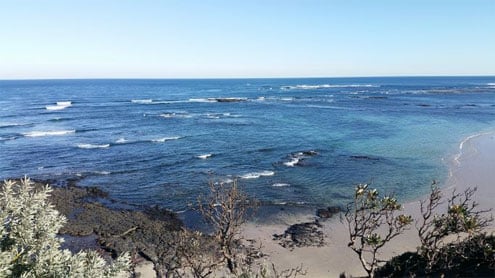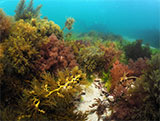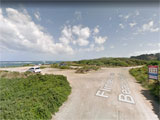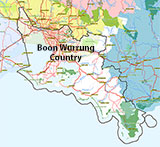Mushroom Reef
![]() Shore Dive |
Shore Dive | ![]() Shore access
Shore access
![]()
![]()
![]()
![]()
![]()
Depth: 3 m (9.84 ft) to 12 m (39 ft)

The Mushroom Reef dive site is much like the Mornington Peninsula Back Beach dives over Portsea and Sorrento way. It is located near Flinders Pier, but is quite exposed. There can be a lot of surge even on calm looking days.
The landscape is quite nice and there are lots of cool leatherjackets and marine life similar to Diamond Bay and St Paul's Road.
Named for its mushroom-shaped reef, this site is a part of the Mushroom Reef Marine Sanctuary which protects 80 hectares of the open coast of Flinders on the Mornington Peninsula and extends offshore to the south for about 1 kilometre. Composed of sandstone rock platforms extending from the shore, the park includes sheltered rock pools, coves and a shallow reef on the ocean side. The reef is formed from ancient basalt which has weathered beautifully, allowing creatures to hide within crevices and cracks or under loose rocks.
This area is famous for its diversity of marine life and has attracted scientists for over 100 years. The intertidal soft-sediment is an important feeding and roosting habitat for many birds. When searching the rock pools one can find many crabs, multicoloured cushion seastars, numerous species of snails and delicate anemones.
The seafloor (2 to 3 metres) is covered with canopy-forming brown algae and patches of seagrass which attract many species of fish such as morwongs, wrasse, cowfish and Victoria's marine emblem, the Weedy Seadragon among the seagrass and kelp. If you're lucky you may be able to spot a Black and White Seastar. This amazing creature is one of only two seastars known to brood its young in its stomach.
The area supports ascidians, gorgonian fans, sponges and corals. Crayfish inhabit rocky crevices, and the subtidal reefs include abalone and sea urchin habitat.
Marine mammals that may pass through the sanctuary include Dolphins, Killer Whales and the threatened Australian Fur Seal, Humpback Whale and Southern Right Whale. All whales and dolphins are protected.
Mushroom Reef is popular with snorkellers at high tide. The sanctuary provides excellent opportunities for underwater diving around spectacular subtidal reefs which are easily accessed from the shore at low tide across the causeway. While there is a heap to see on this 65% subtidal reef, however, caution is needed as it's an unpatrolled ocean beach with strong currents. Basic safety precautions should always be practised.
Because diving and snorkelling equipment can be a vector for marine pests, it should be thoroughly cleaned and dried before being used in the sanctuary.
All forms of extraction, including recreational and commercial fishing and the collection of living or dead organisms and natural driftwood, are prohibited within the sanctuary. The feeding of animals, including fish and birds, is not permitted in the Mushroom Reef Marine Sanctuary.
Mushroom Reef History
Two limestone caves in the cliffs adjacent to the sanctuary in the Mornington Peninsula National Park are likely to contain evidence of the earliest phase of European settlement at Flinders, which was associated with sealing and whaling (Luebbers 1998). There is an oral history of the shipwreck of the Bismarck in 1901 on a subtidal reef now known as Bismarck Reef, adjacent to the sanctuary's southern boundary (E. Lucas pers. comm.).
Location: Flinders, Victoria 3929
MELWAY Ref: Page 261 K11
Parking: There are car parks in the Mornington Peninsula National Park along Golf Links Road, which is reached via West HeadFlinders. The most popular is the Flinders Ocean Beach car park which lies about 300 metres west of the santuary's eastern boundary on the Flinders Ocean Beach Entry Road.
Facilities: Free car park at all times. No toilet and no rubbish bins for litter.
Entry/Exit: It's a short walk from the car park via a short sandy track and stairs close to the main reef platform. At low tide the distinctive mushroom-shaped intertidal area is exposed, providing easy access from the beach to the platform and the offshore reefs. Entry via shore. The intertidal reefs can be snorkelled at high tide.
Although the sanctuary is accessible by boat, few people visit the sanctuary this way because the shallow waters and subtidal reef systems limit access for vessels.
Ideal Conditions: Mushroom Reef faces south in Bass Strait, so it's best to avoid this site during rough weather and south-easterly to south-westerly winds. Best when winds are offshore, i.e. from north-easterly to north-westerly, and the waters are calm with no swell. Best to treat it as a Back Beach dive.
Divers and snorkellers need to be aware of potential dangers, particularly from strong currents. See WillyWeather (Flinders Ocean Beach) as a guide for the tide times and the height of the tide.
A flag indicating 'diver below' should be displayed when scuba divers are in the water. Snorkellers should also adopt this practice when snorkelling, to increase their visibility and safety.
See also, Parks Victoria: Mushroom Reef Marine Sanctury,
Park Note: Mushroom Reef Marine Sanctuary,
Mushroom Reef Marine Sanctuary Visitor Guide,
Mushroom Reef Marine Sanctuary Map,
Mushroom Reef Marine Sanctuary Management Plan — April 2007, and
Flinders Back Beach in "Shore Dives of Victoria" by Ian Lewis, 3rd edition pages 128–129.
Back Beach Warning: Always keep an eye on sea conditions throughout any dive on the Back Beaches of the Mornington Peninsula. Please read the warnings on the web page diving-the-back-beaches before diving or snorkelling this site.
Traditional Owners — This dive site is in the traditional Country of the Boon Wurrung / Bunurong people of the Kulin Nation. This truly ancient Country includes parts of Port Phillip, from the Werribee River in the north-west, down to Wilson's Promontory in the south-east, including the Mornington Peninsula, French Island and Phillip Island, plus Western Port. We wish to acknowledge the Boon Wurrung as Traditional Owners. We pay respect to their Ancestors and their Elders, past, present and emerging. We acknowledge Bunjil the Creator Spirit of this beautiful land, who travels as an eagle, and Waarn, who protects the waterways and travels as a crow, and thank them for continuing to watch over this Country today and beyond.
Mushroom Reef Location Map
Latitude: 38° 28.894′ S (38.48157° S / 38° 28′ 53.65″ S)
Longitude: 145° 0.990′ E (145.016506° E / 145° 0′ 59.42″ E)
Datum: WGS84 |
Google Map
| Get directions
Added: 2018-01-18 10:11:17 GMT, Last updated: 2022-03-27 16:12:52 GMT
Source: Google Earth
Nearest Neighbour: Flinders Back Beach, 238 m, bearing 142°, SE
Mushroom Reef Marine Sanctuary.
Flinders, Back Beaches, Mornington Peninsula.
Depth: 3 to 12 m.
[ Top ]
DISCLAIMER: No claim is made by The Scuba Doctor as to the accuracy of the dive site coordinates listed here. Should anyone decide to use these GPS marks to locate and dive on a site, they do so entirely at their own risk. Always verify against other sources.
The marks come from numerous sources including commercial operators, independent dive clubs, reference works, and active divers. Some are known to be accurate, while others may not be. Some GPS marks may even have come from maps using the AGD66 datum, and thus may need be converted to the WGS84 datum. To distinguish between the possible accuracy of the dive site marks, we've tried to give each mark a source of GPS, Google Earth, or unknown.




